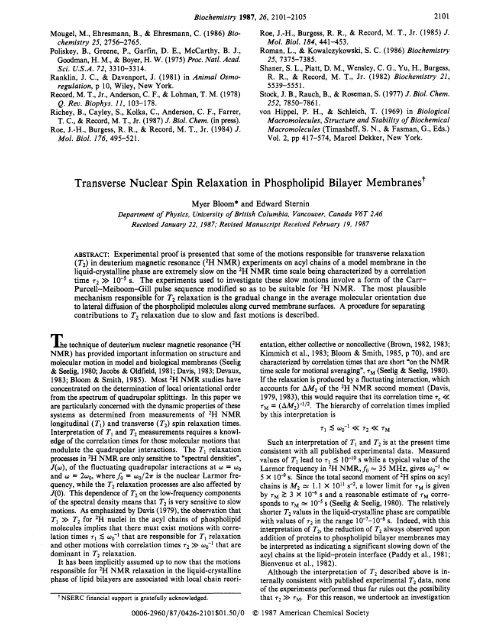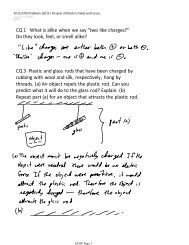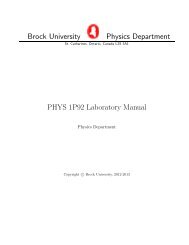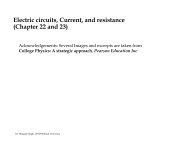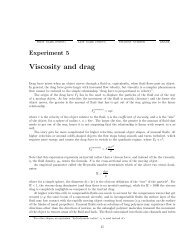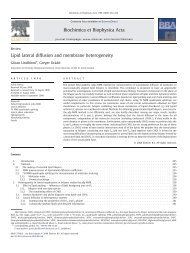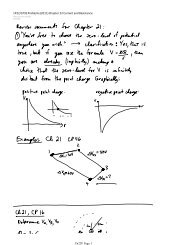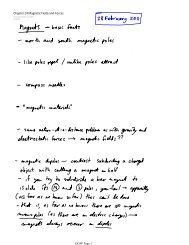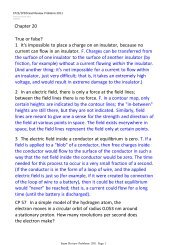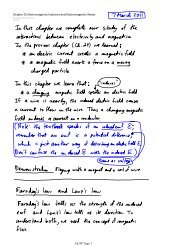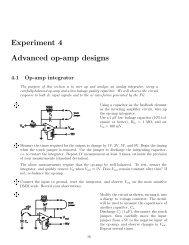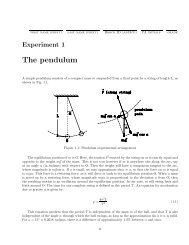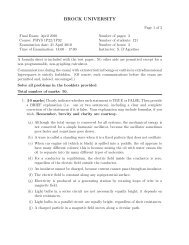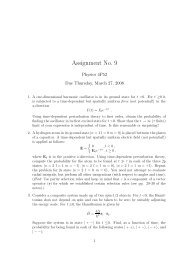Transverse Nuclear Spin Relaxation in Phospholipid Bilayer ...
Transverse Nuclear Spin Relaxation in Phospholipid Bilayer ...
Transverse Nuclear Spin Relaxation in Phospholipid Bilayer ...
You also want an ePaper? Increase the reach of your titles
YUMPU automatically turns print PDFs into web optimized ePapers that Google loves.
Biochemistry 1987, 26, 2101-2105 2101<br />
Mougel, M., Ehresmann, B., & Ehresmann, C. (1986) Biochemistry<br />
25, 2756-2765.<br />
Poliskey, B., Greene, P., Garf<strong>in</strong>, D. E., McCarthy, B. J.,<br />
Goodman, H. M., & Boyer, H. W. (1975) Proc. Natl. Acad.<br />
Sci. U.S.A. 72, 3310-3314.<br />
Rankl<strong>in</strong>, J. C., & Davenport, J. (1981) <strong>in</strong> Animal Osmoregulation,<br />
p 10, Wiley, New York.<br />
Record, M. T., Jr., Anderson, C. F., & Lohman, T. M. (1 978)<br />
Q. Rev. Biophys. 11, 103-178.<br />
Richey, B., Cayley, S., Kolka, C., Anderson, C. F., Farrer,<br />
T. C., & Record, M. T., Jr. (1987) J. Biol. Chem. (<strong>in</strong> press).<br />
Roe, J.-H., Burgess, R. R., & Record, M. T., Jr. (1984) J.<br />
Mol. Biol. 176, 495-521.<br />
Roe, J.-H., Burgess, R. R., & Record, M. T., Jr. (1985) J.<br />
Mol. Biol. 184, 441-453.<br />
Roman, L., & Kowalczykowski, S. C. (1986) Biochemistry<br />
25, 7375-7385.<br />
Shaner, S. L., Piatt, D. M., Wensley, C. G., Yu, H., Burgess,<br />
R. R., & Record, M. T., Jr. (1982) Biochemistry 21,<br />
5539-5551.<br />
Stock, J. B., Rauch, B., & Roseman, S. (1977) J. Biol. Chem.<br />
252, 7850-7861.<br />
von Hippel, P. H., & Schleich, T. (1969) <strong>in</strong> Biological<br />
Macromolecules, Structure and Stability of Biochemical<br />
Macromolecules (Timasheff, S. N., & Fasman, G., Eds.)<br />
Vol. 2, pp 417-574, Marcel Dekker, New York.<br />
<strong>Transverse</strong> <strong>Nuclear</strong> <strong>Sp<strong>in</strong></strong> <strong>Relaxation</strong> <strong>in</strong> <strong>Phospholipid</strong> <strong>Bilayer</strong> Membranes?<br />
Myer Bloom* and Edward Stern<strong>in</strong><br />
Department of Physics, University of British Columbia, Vancouver, Canada V6T 2A6<br />
Received January 22, 1987; Revised Manuscript Received February 19, 1987<br />
ABSTRACT: Experimental proof is presented that some of the motions responsible for transverse relaxation<br />
( T2) <strong>in</strong> deuterium magnetic resonance (2H NMR) experiments on acyl cha<strong>in</strong>s of a model membrane <strong>in</strong> the<br />
liquid-crystall<strong>in</strong>e phase are extremely slow on the 2H NMR time scale be<strong>in</strong>g characterized by a correlation<br />
time 72 >> s. The experiments used to <strong>in</strong>vestigate these slow motions <strong>in</strong>volve a form of the Carr-<br />
Purcell-Meiboom-Gill pulse sequence modified so as to be suitable for 2H NMR. The most plausible<br />
mechanism responsible for T2 relaxation is the gradual change <strong>in</strong> the average molecular orientation due<br />
to lateral diffusion of the phospholipid molecules along curved membrane surfaces. A procedure for separat<strong>in</strong>g<br />
contributions to T2 relaxation due to slow and fast motions is described.<br />
%e technique of deuterium nuclear magnetic resonance (2H<br />
NMR) has provided important <strong>in</strong>formation on structure and<br />
molecular motion <strong>in</strong> model and biological membranes (Seelig<br />
& Seelig, 1980; Jacobs & Oldfield, 1981; Davis, 1983; Devaux,<br />
1983; Bloom & Smith, 1985). Most 2H NMR studies have<br />
concentrated on the determ<strong>in</strong>ation of local orientational order<br />
from the spectrum of quadrupolar splitt<strong>in</strong>gs. In this paper we<br />
are particularly concerned with the dynamic properties of these<br />
systems as determ<strong>in</strong>ed from measurements of 2H NMR<br />
longitud<strong>in</strong>al (T,) and transverse ( T2) sp<strong>in</strong> relaxation times.<br />
Interpretation of TI and T2 measurements requires a knowledge<br />
of the correlation times for those molecular motions that<br />
modulate the quadrupolar <strong>in</strong>teractions. The T1 relaxation<br />
processes <strong>in</strong> 2H NMR are only sensitive to “spectral densities”,<br />
J(o), of the fluctuat<strong>in</strong>g quadrupolar <strong>in</strong>teractions at o = wo<br />
and w = 2w0, where fo = w0/2?r is the nuclear Larmor frequency,<br />
while the T2 relaxation processes are also affected by<br />
J(0). This dependence of T2 on the low-frequency components<br />
of the spectral density means that T2 is very sensitive to slow<br />
motions. As emphasized by Davis (1979), the observation that<br />
T, >> T2 for 2H nuclei <strong>in</strong> the acyl cha<strong>in</strong>s of phospholipid<br />
molecules implies that there must exist motions with correlation<br />
times 7, S coo-’ that are responsible for TI relaxation<br />
and other motions with correlation times 72 >> w0-l that are<br />
dom<strong>in</strong>ant <strong>in</strong> T2 relaxation.<br />
It has been implicitly assumed up to now that the motions<br />
responsible for 2H NMR relaxation <strong>in</strong> the liquid-crystall<strong>in</strong>e<br />
phase of lipid bilayers are associated with local cha<strong>in</strong> reori-<br />
NSERC f<strong>in</strong>ancial support is gratefully acknowledged.<br />
entation, either collective or noncollective (Brown, 1982, 1983;<br />
Kimmich et al., 1983; Bloom & Smith, 1985, p 70), and are<br />
characterized by correlation times that are short “on the NMR<br />
time scale for motional averag<strong>in</strong>g”, T~ (Seelig & Seelig, 1980).<br />
If the relaxation is produced by a fluctuat<strong>in</strong>g <strong>in</strong>teraction, which<br />
accounts for AM2 of the 2H NMR second moment (Davis,<br />
1979, 1983), this would require that its correlation time T,
2102 B IO C H E M I ST R Y ACCELERATED PUBLICATIONS<br />
of this possibility. The results of our study, described <strong>in</strong> this<br />
paper, <strong>in</strong>dicate that, contrary to previous <strong>in</strong>terpretations, a<br />
large fraction of the 2H NMR transverse relaxation rate <strong>in</strong><br />
model membranes is due to molecular motions hav<strong>in</strong>g r2 >><br />
TM.<br />
THEORY<br />
Modified CPMG' Method of Measur<strong>in</strong>g T2. The transverse<br />
relaxation rate <strong>in</strong> 2H NMR is normally denoted by T2$ and<br />
measured with a two-pulse quadrupolar echo (qe) sequence<br />
(Davis et al., 1976; Davis, 1979, 1983) correspond<strong>in</strong>g to<br />
90,-r-9OY-echo. We shall use the notation T2qe to dist<strong>in</strong>guish<br />
such relaxation measurements from those obta<strong>in</strong>ed by other<br />
methods. Then, for exponential relaxation, the result<strong>in</strong>g echo<br />
that is peaked at a time =2r after the first pulse has an amplitude<br />
given by<br />
where (Pauls et al., 1985)<br />
1 / T2qe = A M272 for 72 > rM (2b)<br />
Equations 2a and 2b are written on the assumption that a<br />
s<strong>in</strong>gle molecular motion dom<strong>in</strong>ates the T2 relaxation and that<br />
this motion modulates a portion, AM2, of the second moment.<br />
The generalization of these equations to <strong>in</strong>clude more than<br />
one type of motion is obvious [see, for example, Paddy et al.<br />
(1981), eq 131.<br />
A method of dist<strong>in</strong>guish<strong>in</strong>g between the two limit<strong>in</strong>g regions<br />
of r2 <strong>in</strong> eq 2a and 2b is to use a form of the Carr-Purcell-<br />
Meiboom-Gill (CPMG) pulse sequence (Meiboom & Gill,<br />
1958; Abragam, 1961, pp 58-62) appropriate to 2H NMR.<br />
We shall refer to this sequence, given by 90x-r-(90y-2r-)N,<br />
as the "quadrupolar CPMG sequence" (q-cpmg), though<br />
Blicharski (1986), who has analyzed the transverse relaxation<br />
associated with this sequence theoretically, calls it the "MW-4<br />
sequence", as do others (Mehr<strong>in</strong>g, 1983). If the echoes appear<strong>in</strong>g<br />
at times 2nr, n = 1, 2, ..., N, follow<strong>in</strong>g the first pulse<br />
decay exponentially, then we denote the apparent transverse<br />
relaxation time, referred to by Blicharski as T2,, by T2q-cPmg.<br />
With this notation the amplitude of the nth echo is given by<br />
A(2nr) = A(0) exp ( -- TZmg) (3)<br />
where for fluctuat<strong>in</strong>g quadrupolar <strong>in</strong>teractions governed by<br />
a s<strong>in</strong>gle correlation time<br />
1<br />
(Blicharski, 1986). This result is identical with that obta<strong>in</strong>ed<br />
for the CPMG relaxation rate of sp<strong>in</strong> 'I2 nuclei undergo<strong>in</strong>g<br />
chemical exchange between sites hav<strong>in</strong>g different chemical<br />
shifts (Luz & Meiboom, 1963). In the limit AM2r22 r2 is <strong>in</strong>variably<br />
satisfied, <strong>in</strong> which case eq 4 yields the result T2q-<br />
T2qe; i.e., the quadrupolar CPMG sequence <strong>in</strong>dicates the<br />
same transverse relaxation rate as the two-pulse sequence. Our<br />
<strong>in</strong>terest <strong>in</strong> this pulse sequence is that the opposite limit, AM2r?<br />
' Abbreviations: CPMG, Carr-Purcell-Meiboom-Gill; TLC, th<strong>in</strong>layer<br />
chromatography; FT NMR, Fourier transform nuclear magnetic<br />
resonance.<br />
>> 1 (or r2 >> T ~ ) permits , the experimenter the possibility<br />
of us<strong>in</strong>g values of r
ACCELERATED PUBLICATIONS<br />
x<br />
t<br />
lk<br />
Q)<br />
+<br />
.-<br />
S<br />
0<br />
r<br />
VOL. 26, NO. 8, 1987 2103<br />
y.<br />
0<br />
0)<br />
0<br />
-I<br />
b<br />
I I I I I<br />
0 0.25 0.50 0.75 1<br />
(msec)<br />
FIGURE 1: (a) Schematic representation of the selective data acquisition<br />
scheme used <strong>in</strong> the quadrupolar CPMG experiments, 90,-~-(90,-<br />
h-)~, shown by the dotted l<strong>in</strong>e. Only the data po<strong>in</strong>ts <strong>in</strong> the regions<br />
of <strong>in</strong>terest-near the peaks of the echoes-were recorded, as <strong>in</strong>dicated<br />
by the solid l<strong>in</strong>e. At the last echo the digitizer is switched <strong>in</strong>to a<br />
free-runn<strong>in</strong>g mode, and the entire echo is recorded. For illustrative<br />
purposes we chose N = 5. (b) An example of an actual experimental<br />
data set acquired as <strong>in</strong> (a). Here, N = 32 and T = 100 ps. The time<br />
scale is only shown from the last echo where it becomes cont<strong>in</strong>uous.<br />
data set rises accord<strong>in</strong>gly. With the help of a new pulse<br />
programmer (Stern<strong>in</strong>, 1985) we were able to control the time<br />
base of the A/D converter externally and to selectively acquire<br />
the data po<strong>in</strong>ts only <strong>in</strong> the regions of <strong>in</strong>terest. For a CPMG<br />
pulse sequence these regions are <strong>in</strong> the vic<strong>in</strong>ity of the peaks<br />
of the echoes occurr<strong>in</strong>g at times 2nr, n = 1, 2, ..., N. This<br />
is schematically <strong>in</strong>dicated <strong>in</strong> Figure la. In fact, this efficient<br />
use of the computer memory enabled us to obta<strong>in</strong> <strong>in</strong> the same<br />
experiment the partially relaxed spectra, <strong>in</strong> addition to<br />
measur<strong>in</strong>g the T2qCpmg, by switch<strong>in</strong>g to a free-runn<strong>in</strong>g time<br />
base at the Nth echo.<br />
A partial CYCLOPS phase alternation was used <strong>in</strong> all<br />
experiments to get rid of some of the imperfections <strong>in</strong> the<br />
phases and the lengths of the radio frequency pulses (Rance<br />
& Byrd, 1983). A typical 90° pulse length was =3 ps.<br />
The echo amplitudes were plotted (on a logarithmic scale)<br />
vs. the actual time of the echoes, z2T for T2qe and =2nr for<br />
T2'I-cPW,<br />
EXPERIMENTAL RESULTS<br />
A qe experiment gives a s<strong>in</strong>gle value of A(2r); several<br />
measurements for various values of T are required to determ<strong>in</strong>e<br />
T2qe. In contrast, a s<strong>in</strong>gle quadrupolar CPMG experiment (see,<br />
for example, Figure lb) gives a number of po<strong>in</strong>ts, A(2nr), n<br />
= 1, 2, ..., N, and thus is sufficient to determ<strong>in</strong>e T2qcpmg. A<br />
summary of experiments performed dur<strong>in</strong>g this study of a<br />
model membrane of pure DPPC-d31 is presented <strong>in</strong> Figure 2.<br />
As can be seen, the data from the qe experiments fit well to<br />
a s<strong>in</strong>gle exponent; a least-squares fit yields T2qe = 214 f 5 ps.<br />
The data from the quadrupolar CPMG experiments is strongly<br />
nonexponential. At short times (first few echoes), the relax-<br />
7 T2P-cpmg (ps) T2'I-cpmg (ps)<br />
(PS) (<strong>in</strong>itial slopes) (2.5 ms 6 t 6 4 ms)<br />
100 643 f 15<br />
1322 f 25<br />
160 609 1277<br />
200 551 1290<br />
260 483 1250<br />
300 439 1256<br />
'Measurements for various values of 7 are presented. By comparison,<br />
T2qe = 214 k 5 ps.<br />
ation rates exhibit a strong r dependence, while at longer times<br />
the relaxation rates appear to become <strong>in</strong>dependent of r. The<br />
results of least-squares fits to the <strong>in</strong>itial few echoes and to the<br />
echoes fall<strong>in</strong>g <strong>in</strong>to the <strong>in</strong>terval between 2.5 and 4 ms are<br />
presented <strong>in</strong> Table I.<br />
Note that the first echo of a quadrupolar CPMG experiment<br />
is exactly equivalent to the appropriate qe experiment; thus<br />
for all r values the quadrupolar CPMG echo curves should<br />
start from the T2qe l<strong>in</strong>e, as they do to with<strong>in</strong> experimental error.<br />
In all of the quadrupolar CPMG experiments 32 echoes were<br />
recorded but only the echoes occurr<strong>in</strong>g at times shorter than<br />
=4 ms are presented <strong>in</strong> Figure 2.<br />
DISCUSSION<br />
<strong>Transverse</strong> <strong>Relaxation</strong> due to Diffusion along Curved<br />
Membrane Surfaces. As may be seen from Figure 2, the<br />
characteristic relaxation <strong>in</strong> a quadrupolar CPMG experiment<br />
is nonexponential. Thus the results cannot be <strong>in</strong>terpreted <strong>in</strong><br />
terms of a s<strong>in</strong>gle relaxation time as implied by eq 3. Nevertheless,<br />
the experimental results <strong>in</strong>dicate unambiguously that<br />
correlation times much longer than hundreds of microseconds<br />
play an important role <strong>in</strong> the transverse relaxation of the 2H<br />
NMR signal of DPPC-d3, <strong>in</strong> the liquid-crystall<strong>in</strong>e state.<br />
The motion that is a prime candidate for such long correlation<br />
times is diffusion along curved membrane surfaces. For<br />
example, the correlation time of quadrupolar <strong>in</strong>teractions for<br />
molecules diffus<strong>in</strong>g on the surface of a sphere of radius R with<br />
a diffusion constant D is given by (Abragam, 1961, pp 298-<br />
300; Bloom et al., 1978)<br />
r2 = R2/6D (6)
2104 B IOC H E M IS T R Y<br />
ACCELERATED PUBLICATIONS<br />
' t /<br />
?<br />
1400 -<br />
I- I of about 1.6 pm. In this section we mention briefly additional<br />
theoretical and experimental results which <strong>in</strong>dicate that lateral<br />
diffusion is, <strong>in</strong>deed, responsible for the long correlation times<br />
established by our experiments. These po<strong>in</strong>ts will be described<br />
more fully <strong>in</strong> a subsequent paper,<br />
We have developed a theory of transverse relaxation <strong>in</strong><br />
which the diffusion equation is explicitly solved for the lateral<br />
diffusion along a curved surface. Our calculation shows that<br />
the relaxation curve <strong>in</strong> the two-pulse qe experiment should be<br />
I I I I I I I I 1<br />
T2 (x10-8 s*c2)<br />
FIGURE 3: Initial slopes of the relaxation curves of Figure 2 vs. T ~ .<br />
The actual<br />
-<br />
values of T29mg are listed <strong>in</strong> Table I. The solid l<strong>in</strong>e is<br />
the result of a least-squares fit to eq 7, yield<strong>in</strong>g (1/Ti) = 1 /695 ps<br />
and T~ 100 ms.<br />
S<strong>in</strong>ce the sample has a distribution of values of R, AM2,<br />
and bilayer orientations, the nonexponential relaxations observed<br />
<strong>in</strong> Figure 2 are not unexpected. However, the <strong>in</strong>itial<br />
slopes of the relaxation curves of Figure 2 are exactly equal<br />
to ( 1 / T2*a), where (...) denotes the average over all of these<br />
parameters. A plot of these <strong>in</strong>itial slopes of the relaxation<br />
curves of Figure 2 vs. r2 is shown <strong>in</strong> Figure 3 to be l<strong>in</strong>ear as<br />
predicted by eq 5.<br />
S<strong>in</strong>ce the motions associated with the long correlation times<br />
are too slow to contribute to motional averag<strong>in</strong>g, they are only<br />
capable of gradually modulat<strong>in</strong>g the quadrupolar splitt<strong>in</strong>gs,<br />
which armnemmd <strong>in</strong> the 2H NMR spectrum. For spherical<br />
bilayers we may, therefore, identify ( AM2) with the "residual<br />
second moment", M2,, of the *H NMR spectrum (Bloom et<br />
al., 1978; Davis, 1979). Substitut<strong>in</strong>g eq 6 <strong>in</strong>to eq 5 and de-<br />
f<strong>in</strong><strong>in</strong>g an effective radius for diffusional relaxation, Reff, by<br />
RefC2 = (K2), we obta<strong>in</strong><br />
The l<strong>in</strong>ear plot <strong>in</strong> Figure 3 gives 2M2@/Reff2 = 93 X 10' s-~<br />
and ( 1 / Ti) = 1 /695 ps. For lipid bilayers hav<strong>in</strong>g a diffusion<br />
constant D i= 4 X 10-l2 m2 s-' (Bloom et al., 1978) and a value<br />
of M2r that we measured to be M2r = 3.0 X lo9 s-~, <strong>in</strong><br />
agreement with Davis (1979), we obta<strong>in</strong> Reff = 1.6 pm and,<br />
substitut<strong>in</strong>g <strong>in</strong>to eq 6, r2 = 100 ms. As noted by Hope et al.<br />
( 1986), multilamellar phospholipid dispersions prepared <strong>in</strong> the<br />
manner we have described "exhibit broad size distributions<br />
centered around diameters of a micron or more". An <strong>in</strong>dependent<br />
measurement of the average size of the dispersions<br />
<strong>in</strong> our DPPC sample by means of light scatter<strong>in</strong>g (Stern<strong>in</strong>,<br />
unpublished results) confirms this estimate.<br />
CONCLUSIONS<br />
We have demonstrated <strong>in</strong> this paper that 2H NMR transverse<br />
relaxation <strong>in</strong> DPPC bilayers is strongly <strong>in</strong>fluenced by<br />
molecular motions hav<strong>in</strong>g correlation times much longer than<br />
hundreds of microseconds. The most plausible candidate for<br />
such slow motions is diffusion of the phospholipid molecules<br />
along the curved membrane surfaces. This motion modulates<br />
the precession frequency <strong>in</strong> a random manner because the 2H<br />
NMR quadrupolar splitt<strong>in</strong>g is proportional to 3 cos2 8 - 1,<br />
where 8 is the angle between the local bilayer normal and the<br />
external magnetic field. Indeed, the theoretical results of<br />
Blicharski (1 986) fit the r2 dependence of the average CPMG<br />
relaxation rate for a plausible membrane radius of curvature<br />
I<br />
j<br />
nonexponential <strong>in</strong> analogy with the case of diffusion <strong>in</strong> an<br />
<strong>in</strong>homogeneous magnetic field (Abragam, 1961). It also<br />
confirms the use of eq 7 for the average relaxation rate, assum<strong>in</strong>g<br />
a s<strong>in</strong>gle correlation time model. This more general<br />
treatment predicts the dependence of the relaxation rate on<br />
bilayer orientation to be ( 1/T2q-Cpmg) c: s<strong>in</strong>2 8 cos2 8 at short<br />
times. Our unpublished results on specifically labeled lipid<br />
cha<strong>in</strong>s are <strong>in</strong> agreement with this prediction. We f<strong>in</strong>d that<br />
the <strong>in</strong>itial relaxation rate is slowest near the spectral edges of<br />
the 2H NMR powder spectra correspond<strong>in</strong>g to 8 = 90' and<br />
near the shoulders at 8 = 0'. Such an angular dependence<br />
has been observed empirically <strong>in</strong> 2tI-labeled lipids by Perly<br />
et al. (1985, see Figure 4). A similar behavior was observed<br />
for 2H NMR of heavy water, 2H20, <strong>in</strong> contact with membrane<br />
surfaces (Volke, 1984). In addition, our sample consists of<br />
31 2H nuclei per molecule, many of which have different<br />
quadrupolar splitt<strong>in</strong>gs; this results <strong>in</strong> an additional distribution<br />
of relaxation rates. A complicated superposition of nonexponential<br />
relaxation contributions leads <strong>in</strong> this case to the<br />
exponential behavior observed <strong>in</strong> the qe experiment.<br />
By means of the quadrupolar CPMG pulse tra<strong>in</strong> described<br />
here, it is now possible to separate the contributions of extremely<br />
long correlation times to transverse relaxation. Systematic<br />
study of the rema<strong>in</strong><strong>in</strong>g contribution, denoted by Ti<br />
<strong>in</strong> eq 5 and 7, will give <strong>in</strong>formation on the slowest of the<br />
conformational motions. This will be useful <strong>in</strong> the study of<br />
lipid-prote<strong>in</strong> <strong>in</strong>teractions. The methods used <strong>in</strong> this paper<br />
could also be applied to detect a wide class of slow motions<br />
<strong>in</strong> membranes, such as conformational changes <strong>in</strong> <strong>in</strong>tegral<br />
membrane prote<strong>in</strong>s or motions associated with lipids bound<br />
to such prote<strong>in</strong>s.<br />
ACKNOWLEDGMENTS<br />
We thank Prof. R. J. Cushley for provid<strong>in</strong>g the lipids used<br />
<strong>in</strong> this study, Dr. C. P. S. Tilcock for his help <strong>in</strong> prepar<strong>in</strong>g<br />
the samples, and U. Narger for her assistance with the light<br />
scatter<strong>in</strong>g measurements. We are grateful to J. C. Wallace<br />
for shar<strong>in</strong>g her data, and we thank her and Dr. A. L. MacKay<br />
for helpful discussions.<br />
REFERENCES<br />
Abragam, A. (1961) The Pr<strong>in</strong>ciples of <strong>Nuclear</strong> Magnetism,<br />
Oxford University Press, London.<br />
Bienvenue, A., Bloom, M., Davis, J. H., & Devaux, P. F.<br />
(1982) J. Biol. Chem. 257, 3032-3038.<br />
Blicharski, J. S. (1986) Can. J. Phys. 64, 733-735.<br />
Bloom, M., & Smith, I. C. P. (1985) <strong>in</strong> Progress <strong>in</strong> Prote<strong>in</strong>-<br />
Lipid Interactions (Watts, A., & DePont, J. J. H. H. M.,<br />
Eds.) pp 61-88, Elsevier, New York.<br />
Bloom, M., Burnell, E. E., MacKay, A. L., Nichol, C. P.,<br />
Valic, M. I., & Weeks, G. (1978) Biochemistry 17,<br />
5750-5 762.<br />
Brown, M. F. (1982) J. Chem. Phys. 77, 1576-1599.<br />
Brown, M. F. (1983) Proc. Natl. Acad. Sci. U.S.A. 80,<br />
4325-4329.<br />
Davis, J. H. (1979) Biophys. J. 27, 339-358.<br />
Davis, J. H. (1983) Biochim. Biophys. Acta 737, 117-171.
Biochemistry 1987, 26, 2105-21 16 2105<br />
Davis, J. H., Jeffrey, K. R., Bloom, M., Valic, M. I., & Higgs,<br />
T. P. (1976) Chem. Phys. Lett. 42, 390-394.<br />
Devaux, P. F. (1983) Biol. Magn. Reson. 5, 183-299.<br />
Hope, M. J., Bally, M. B., Mayer, L. D., Janoff, A. S., &<br />
Cullis, P. R. (1986) Chem. Phys. Lipids 40, 89-107.<br />
Jacobs, R. E., & Oldfield, E. (1981) Prog. Nucl. Magn. Reson.<br />
Spectrosc. 14, 1 13-1 36.<br />
Kimmich, R., Shuur, G., & Scheurmann, A. (1983) Chem.<br />
Phys. Lipids 32, 271-322.<br />
Luz, Z., & Meiboom, S. (1963) J. Chem. Phys. 39,366-370.<br />
Mehr<strong>in</strong>g, M. (1983) Pr<strong>in</strong>ciples of High-Resolution NMR <strong>in</strong><br />
Solids, Spr<strong>in</strong>ger-Verlag, Berl<strong>in</strong>.<br />
Meiboom, S., & Gill, D. (1958) Rev. Sci. Instrum. 29,<br />
688-691.<br />
Paddy, M. R., Dahlquist, F. W., Davis, J. H., & Bloom, M.<br />
(1981) Biochemistry 20, 3152-3162.<br />
Pauls, K. P., MacKay, A. L., Soderman, O., Bloom, M.,<br />
Taneja, A. K., & Hodges, R. S. (1985) Eur. Biophys. J.<br />
12, 1-11.<br />
Perly, B., Smith, I. C. P., & Jarrel, H. C. (1985) Biochemistry<br />
24, 4659-4665.<br />
Rance, M., & Byrd, R. A. (1983) J. Magn. Reson. 52,<br />
22 1-240.<br />
Seelig, J., & Seelig, A. (1980) Q. Rev. Biophys. 13, 19-61.<br />
Stern<strong>in</strong>, E. (1985) Rev. Sci. Instrum. 56, 2043-2049.<br />
Volke, F. (1984) Chem. Phys. Lett. 112, 551-554.<br />
Wallace, J. C. (1986) MSc. Thesis, Department of Biology,<br />
University of British Columbia.<br />
Art ides<br />
Destabilization of Phosphatidylethanolam<strong>in</strong>e-Conta<strong>in</strong><strong>in</strong>g Liposomes: Hexagonal<br />
Phase and Asymmetric Membraned<br />
Joe Bentz,* Harma Ellens,* and Francis C. Szoka<br />
Departments of Pharmacy and Pharmaceutical Chemistry, School of Pharmacy, University of California, San Francisco,<br />
California 941 43<br />
Received April 4, 1986; Revised Manuscript Received October 28, 1986<br />
ABSTRACT: We have measured the temperature of the L,-HII phase transition, TH, for several types of<br />
phosphatidylethanolam<strong>in</strong>e (PE), their b<strong>in</strong>ary mixtures, and several PE/cholesteryl hemisucc<strong>in</strong>ate (CHEMS)<br />
mixtures. We have shown for liposomes composed of pure PE and <strong>in</strong> mixtures with CHEMS that there<br />
is an aggregation-mediated destabilization which is greatly enhanced at and above TH. We now ask the<br />
question: How well can a dioleoylphosphatidylethanolam<strong>in</strong>e/CHEMS liposome, for example, destabilize<br />
TPE (transesterified from egg phosphatidylchol<strong>in</strong>e)/CHEMS liposome and vice versa? We use Ca2+ and<br />
H+ to <strong>in</strong>duce aggregation and to provide different values of TH: the TH of the PE/CHEMS mixture is<br />
much lower at low pH than with Ca2+. We f<strong>in</strong>d that if the temperature is above the TH of one lipid mixture,<br />
e.g., A, and below the TH of the other lipid mixture, e.g., B, then the destabilization sequence [measured<br />
by the fluorescent 1 -am<strong>in</strong>onaphthalene-3,6,8-trisulfonic acidlp-xylylenebis(pyrid<strong>in</strong>ium bromide) leakage<br />
assay] is AA > AB >> BB. That is, the bilayer of the lipid A (which on its own would end up <strong>in</strong> the HII<br />
phase) destabilizes itself better than it destabilizes the bilayer of lipid B (which on its own would rema<strong>in</strong><br />
<strong>in</strong> the L, phase). The BB contact is the least unstable. From these experiments, we conclude that the<br />
enhanced destabilization of membranes provided by the polymorphism accessible to these lipids above TH<br />
is effective even if only one of the apposed outer monolayers is HII phase competent. The surpris<strong>in</strong>g result<br />
is that if the temperature is above the TH of both lipid mixtures, then the destabilization sequence is AB<br />
> AA, BB. That is, the mixed bilayers are destabilized more by contact than either of the pure pairs. We<br />
believe that this is due to specific differences <strong>in</strong> the k<strong>in</strong>etics of aggregation or close approach of the membranes.<br />
Similar results were obta<strong>in</strong>ed with pure PE liposomes <strong>in</strong>duced to aggregate by Ca2+ at pH 9.5. We also<br />
found that the k<strong>in</strong>etics of low-pH-<strong>in</strong>duced leakage from PE/CHEMS liposomes were <strong>in</strong>itially faster when<br />
the CHEMS on both sides of the bilayer is fully protonated. However, <strong>in</strong> a citrate buffer, which cannot<br />
cross <strong>in</strong>tact membranes, the leakage was eventually faster. Flip-flop of the protonated CHEMS to the <strong>in</strong>ner<br />
monolayer can expla<strong>in</strong> this observation.<br />
%e ability of many naturally occurr<strong>in</strong>g lipids to undergo a<br />
bilayer L, to hexagonal HI* phase transition has led to much<br />
'This <strong>in</strong>vestigation was supported by Research Grants GM-31506<br />
(J.B.) and GM-29514 (F.C.S.) from the National Institutes of Health<br />
and by an Academic Senate Research Grant from the University of<br />
California (J.B.).<br />
*Address correspondence to this author at the Department of Pharmacy,<br />
University of California, San Francisco.<br />
*Present address: Department of Pharmacology, School of Medic<strong>in</strong>e,<br />
University of California, San Francisco, CA 94143.<br />
0006-2960/87/0426-2105$01.50/0<br />
speculation about the putative roles of this polymorphism <strong>in</strong><br />
cell function [for reviews, see Cullis & de Kruijff (1979),<br />
Verkleij (1984), Siege1 (1984, 1987a), Rilfors et al. (1984),<br />
Cullis et al. (1985), Gruner et al. (1985), L<strong>in</strong>dblom et al.<br />
(1986), Weislander et al. (1986), and Qu<strong>in</strong>n et al. (1986)l.<br />
For the L,-HII phase transition to be relevant for biological<br />
membrane fusion, it must satisfy three criteria: (i) it must<br />
occur after the contact of the two membranes; (ii) it must<br />
result <strong>in</strong> the mix<strong>in</strong>g of aqueous contents between the membrane-bound<br />
compartments; and (iii) it must function between<br />
0 1987 American Chemical Society


